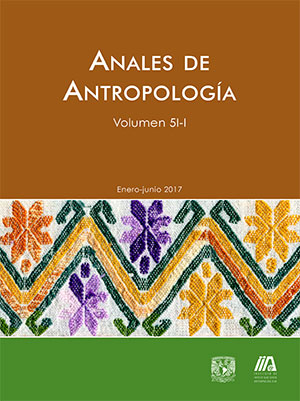The provenance of Teotihuacan mica: the control of sumptuary foreign goods by the ruling elite
Main Article Content
Abstract
This article describes the provenance and contexts in which mica (phlogopite or biotite) has been found, as a foreign raw material imported from the Valley of Oaxaca, in the great metropolis of Teotihuacan in Central Mexico, during the Classic period (first 6 centuries CE). More than 90% of the mica found in the Classic city is concentrated in two compounds at Teotihuacan: the Xalla Palace, to the north of the Sun Pyramid, and the Viking Group, to the south of the Sun Pyramid, both sites that were related to the city’s governing elite. In contrast to the large amount of mica in these contexts is the small amount (measured in grams) found in multi-ethnic neighborhood centers such as Teopancazco, which were also excavated by this project.
The approximately 37 kg of sheet mica found in Xalla during the project “Teotihuacan. Elite and government” (Linda R. Manzanilla, 1997-2016) occurs as cut plaques, triangles, trapezoidal figures, rectangles and circles, as well as flake mica and dust. At Xalla, they were used on the lower part of the walls; as circles incorporated as “eyes” in theater-type censers found in Oztoyahualco 15B; and as disks and angular geometric figures in important burials at Teopancazco.
Through archaeometric studies (X-ray diffraction, scan electron microscopy, neutron activation), mica from Xalla and Teopancazco is cha- racterized and compared with sources of mica in the Valley of Oaxaca (Las Trancas near San Francisco Telixtlahuaca, Paraje Loma Gorda near Cuilapan, Loma Yaguín near Santo Tomás Jalieza, the modern mine of Minerales de Antequera S.A. in Ocotlán de Morelos) and with Prehispanic mica from the archaeological sites of Monte Albán, Cerro de las Minas, and Huamelulpan in Oaxaca. Most of the Prehispanic mica may have come from the area of the modern mine of Minerales de Antequera S.A. in Ejutla.
Downloads
Article Details
Citas en Dimensions Service
Esta revista usa una licencia CC del tipo CC BY-NC-ND 3.0. Se maneja bajo el esquema de acceso abierto, con una licencia Creative Commons Attribution-NonCommercial-NoDerivs 3.0 Unported.
